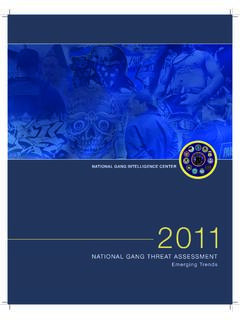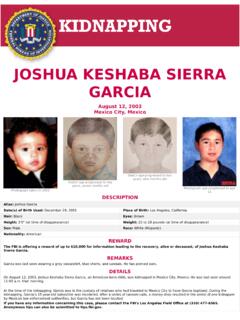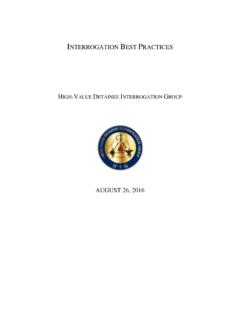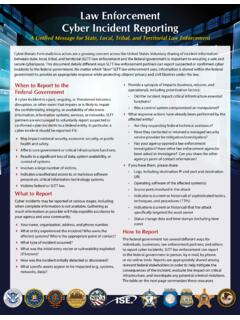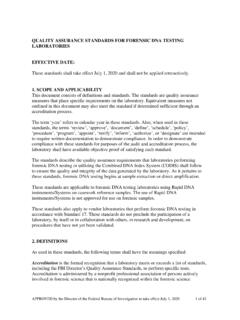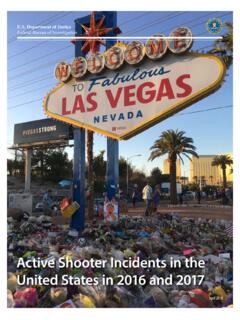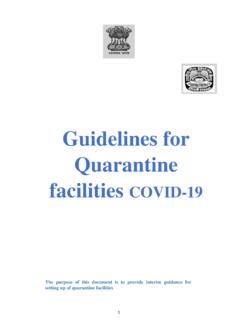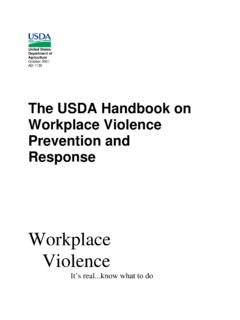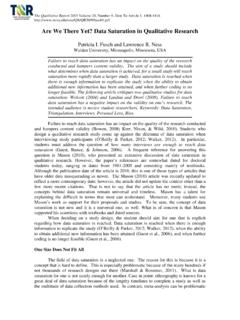Transcription of Making Prevention a Reality - Federal Bureau of …
1 U. S. Department of Justice Federal Bureau of Investigation Making Prevention a Reality : Identifying, Assessing, and Managing the Threat of Targeted Attacks Behavioral Analysis Unit National Center for the Analysis of Violent Crime Behavioral Threat assessment Center National Center for the Analysis of Violent Crime Critical Incident Response Group Federal Bureau of Investigation ii AUTHORS. This publication was authored by members of the Federal Bureau of Investigation's Behavioral Analysis Unit: Molly Amman Karie A. Gibson Supervisory Special Agent Supervisory Special Agent Federal Bureau of Investigation Federal Bureau of Investigation Matthew Bowlin Sarah H. Griffin Special Agent Special Agent Capitol Police Naval Criminal Investigative Service Lesley Buckles Kirk Kennedy Crime Analyst Operational Psychologist Federal Bureau of Investigation Federal Bureau of Investigation Kevin C. Burton Cari J.
2 Robins Unit Chief Supervisory Special Agent Federal Bureau of Investigation Federal Bureau of Investigation Kimberly F. Brunell Supervisory Special Agent Federal Bureau of Investigation iii Table of Contents Message from the FBI vii Foreword .. ix Acknowledgments .. x Introduction .. 1. Chapter 1 Awareness: Initial Step Toward Change .. 3. Violence is gender 3. Diminishing the violent offender .. 3. These offenders don't snap they decide .. 4. Threat assessment .. 4. Research .. 5. Barriers to successful 6. Early recognition of barriers .. 8. Self 8. Information sharing .. 9. Violence and mental illness .. 9. Behavior, not diagnosis .. 9. Chapter 2 Identification: An Essential Step for Threat Management .. 11. Low probability/high impact events .. 11. Bystanders become upstanders .. 11. Opportunities for identification .. 13. Reporting and reporting mechanisms .. 14. Creating a culture of shared responsibility.
3 14. Making a threat versus posing a 15. Intimacy effect .. 16. Anonymous communicated threats .. 18. Analysis of threatening communications .. 18. First Amendment protected 19. iv Chapter 3 assessment : Analysis for Guiding 21. There are no usual suspects .. 21. Data interpretation and weighting .. 21. Bias .. 21. Triage versus 360 23. Pathway to violence .. 24. The role played by mental illness .. 25. The person of concern .. 28. Brittle 28. Conducting the 29. Threat enhancers .. 29. Risk factors .. 29. Warning behaviors .. 32. Indicators of potential imminence .. 36. Triggers and 37. Mitigators .. 37. Level of concern .. 39. Awareness of scrutiny .. 40. Targeting .. 41. Relationship to grievance .. 41. Relationship to psychosis .. 42. Family, loved ones, 42. Information gathering .. 43. Data sources .. 45. Relevance of data .. 46. Interviews .. 48. 49. Open source .. 49. Social media and the internet.
4 49. Chapter 4 Management: The Prevention Plan .. 51. Safety and caretaking .. 51. v Assumption of responsibility .. 51. Prevention , not prediction .. 53. Management spectrum options .. 54. Person of concern .. 54. Situation .. 62. Setting .. 63. Target .. 64. Zero tolerance policies .. 64. Caution against becoming the grievance/last straw .. 64. Mental health is not the answer threat management is the key .. 65. Implement and reassess .. 67. Family .. 67. Threat management is like good parenting .. 69. Chapter 5 Threat Management Team: The Set Up .. 70. Why threat management teams work .. 70. Logistics .. 70. Multidisciplinary .. 71. Co-deployment 71. Team establishment .. 72. Core and ad hoc membership .. 72. New 74. Process .. 74. Recordkeeping .. 76. Retiring or transferring a case ..78. Competing assessments .. 79. Becoming and staying 79. One team, one goal .. 80. Setting up a policy .. 80. Conclusion.
5 82. Appendix A Levels of Concern .. 84. Appendix B Tripwires and Warning Signs .. 90. vi Appendix C Threat assessment and Management Process.. 92. Appendix D Tarasoff/Duty to Warn and Duty to Protect .. 93. Appendix E Glossary of Terms .. 95. Appendix F 100. Appendix G Symposium Agenda .. 107. Endnotes .. 109. vii Message from the FBI Director Every day in America, acts of planned violence are carried out against innocent people simply going about their lives. The mass shootings we see so frequently today are a dramatic example. I know many Americans feel that no place is safe schools, places of worship, worksites, or public gatherings. Fear like that can become disabling, and that is no way to live. The FBI is committed to Making our country safer by finding ways to reduce attacks like mass shootings, and other forms of targeted violence such as stalking, terrorism, or ambush attacks on law enforcement.
6 For years, the FBI and other law enforcement agencies, academic researchers, mental health experts, and the news media have studied this problem. In 2015, the FBI's Behavioral Analysis Unit brought together a multidisciplinary group of experts to collaborate on solutions. This monograph represents the collective experiences and insights of the Behavioral Analysis Unit and these experts. We hope it serves as a practical guide to threat assessment and management. It is intended for novice and experienced professionals alike, and I believe it offers something for all of us who are paid to investigate and stop such acts of violence. The best way to counter any threat is to combine knowledge, experience, and cooperation with our partners. We must all work as a team. I am grateful to all those who helped create this guide for their time, their expertise, and their commitment to public safety. I hope this helps you better understand and ultimately prevent targeted acts of violence in your communities.
7 Thank you for Making the choice to do good for a living and for serving the people of this great country. James B. Comey Director Federal Bureau of Investigation viii ix Foreword The FBI's National Center for the Analysis of Violent Crime (NCAVC) is part of the Critical Incident Response Group (CIRG) located at the FBI Academy at Quantico, Virginia, and consists of FBI Special Agents and professional support staff, and representatives from other Federal agencies and departments. The NCAVC provides operational support in the areas of counterterrorism, counterintelligence, cyber crimes, crimes against children, crimes against adults, and threat assessment . The Behavioral Threat assessment Center (BTAC) is the NCAVC's center of expertise for threat assessment and management. Cases accepted by the BTAC often include post-incident analysis of completed attacks; person of concern cases in school, workplace and other contexts; stalking; threats and extortion; and other forms of planned violence.
8 The BTAC reviews cases from behavioral, investigative, and legal perspectives, offering a range of services for law enforcement agencies around the country and the world. Services include behavioral threat assessments and management strategies, interview strategies, prosecutorial strategies, on-site deployments to assist with investigations of completed attacks, and more. Products generated by the BTAC serve as operational tools for client law enforcement agencies to help them effectively prioritize resources and plan investigative and violence Prevention strategies. The BTAC also conducts research into targeted violence from a law enforcement perspective in an effort to gain insight into criminal thought processes, motivations, and behaviors. Results of this research are shared with law enforcement and academic communities through publications, presentations, and training, as well as through application of knowledge to the investigative and operational functions of the BTAC.
9 Assistance of the BTAC can be requested by law enforcement agencies. They may request it through one of the FBI's 56 domestic FBI field offices or 64 legal attach offices in US embassies around the world, in furtherance of their own investigations or in responding to a request by a community, school, employer, or other entity. One goal of this guide is to educate and empower communities to address some of these issues independently. The BTAC, working with experts in targeted violence and threat assessment and looking at the active shooter problem from a law enforcement and behavioral perspective, wanted to examine promising strategies for preventing these attacks. From July 26 to 28, 2015, the BTAC hosted a symposium at the University of Virginia, Charlottesville, Virginia. A collaborative group consisting of representatives from law enforcement, academia, law, and mental health, along with members of the BTAC and the NCAVC, came together to share expertise and experiences on this important issue.
10 The agenda included presentations and working group sessions on relevant topics in the field of threat management. This monograph is the culmination of those efforts, outlining consensus views and offering BTAC experiences with recommended practices in a field that is evolving. It is hoped this monograph will serve as a useful and practical guide for understanding and implementing threat assessment and management at all levels. x Acknowledgments The Behavioral Analysis Unit gratefully acknowledges the intellectual and professional contributions from participants in its 2015 symposium on targeted violence Prevention : Emma Barrett, PhD Leonard Johns Research Fellow Lancaster, Section Chief United Kingdom National Center for the Analysis of Violent Crime Richard Bonnie, LLB Federal Bureau of Investigation Professor of Law Sally C. Johnson, MD. University of Virginia School of Law Clinical Professor Susan Davis, JD Clinical Director of Forensic Psychiatry Clinic Associate Vice President for Student Affairs University of North Carolina, Chapel Hill School University of Virginia of Medicine Jeffrey Dunn Mavis Manson Officer-in-Charge Supervisory Management and Program Analyst Threat Management Unit National Center for the Analysis of Violent Los Angeles Police Department Crime Robert Fein, PhD Federal Bureau of Investigation Consulting Psychologist The Honorable Edwin Meese III, JD.
